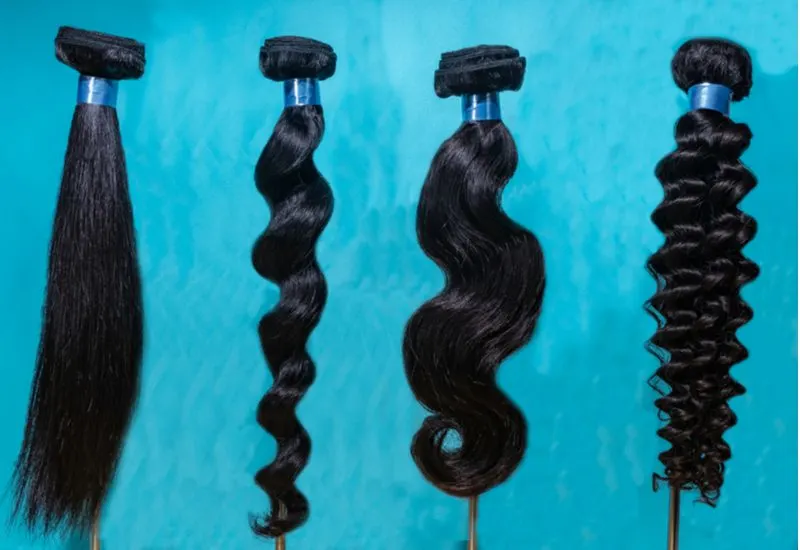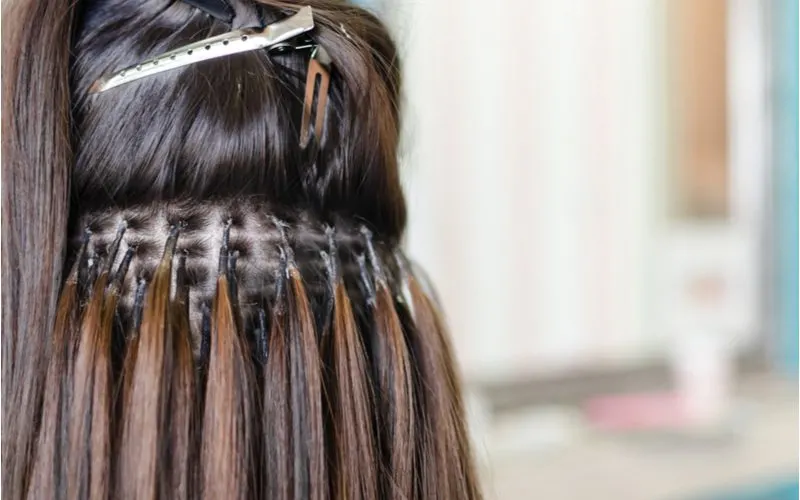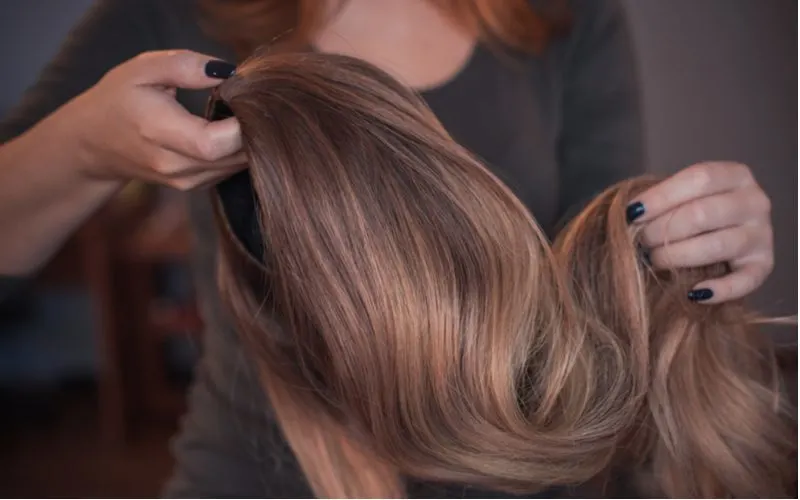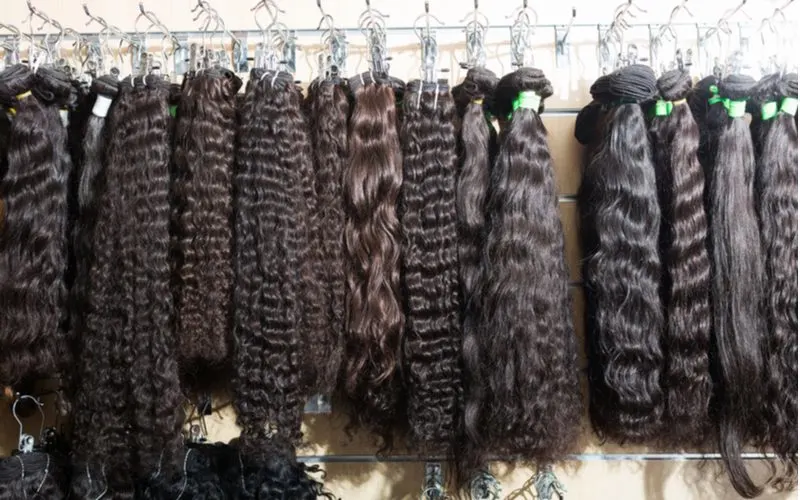Jump to:
Shopping for hair extensions and wondering, “just what is virgin hair?” This guide is for you. Read on to see characteristics, pros and cons, how long it lasts, and how it compares with other types of hair.
Wondering About Virgin Hair?
Virgin human hair is one of the most commonly advertised – and most expensive – types of hair in the extension and wig world. You’re smart to question if the term “virgin hair” really makes a wig or extension set worth the splurge.
After all, virgin extensions, hair pieces, and wigs can cost hundreds more than their synthetic counterparts. Virgin extensions and wigs are absolutely essential for some types of wear. But you can easily get by with cheaper options in some cases.
We’ll talk about that in depth and help you understand when virgin hair is worth the additional expense in this guide. You’ll find out what virgin hair is, pros and cons, how long it lasts, how it compares to other extension and wig hair types, and whether it’s worth splurging on. Let’s get started!
What Is Virgin Hair?
Virgin hair is unprocessed, natural human hair used to make wigs, hair pieces, and hair extensions. Virgin hair has never been chemically processed, either while on the donor’s head or during the wig- or extension-manufacturing process.
This means virgin hair has never been dyed/colored, bleached, highlighted, permed, chemically straightened, or relaxed. If the hair was dyed or chemically processed even one time, it’s not virgin hair.
As you can imagine, that makes the pool of prospective virgin hair donors pretty shallow. Most women have some type of chemical processing done to their hair at some point. And since the hair must be at least 8 inches long to donate, the prospective pool of virgin hair donors gets even smaller.
That’s the reason real virgin human hair is so expensive. It’s much harder to get! It can’t be manufactured or made. You have to source this premium quality of hair from donors who avoid chemical processing of any kind and are willing to donate at least 8 inches of hair.
So when companies source high quality virgin human hair from donors and arrange it into premium hair extensions, hair pieces, and wigs, they charge a lot more for it than they do lower-quality hair types.
Virgin Hair vs. Remy Hair

Photo_Time/Shutterstock
Virgin human hair is considered to be very high quality and many women won’t even consider using hair extensions or wigs that don’t use it. But how does virgin hair compare with remy hair?
Remy hair is another phrase you’ll see on different types of wigs and extensions. Remy hair refers to human hair that has been collected from the donor in a bundle with all strands running in the same direction.
In remy hair, the outermost cuticle layer of the hair is still intact. This means the hair tangles less, doesn’t mat easily, feels smoother, and looks shinier with less pesky shedding. Let’s start with what the two types have in common.
Both virgin and remy hair are human hair. Both are used to make wigs, extensions, and hair pieces. And both are considered to be high quality hair types that are safe to heat style, dye, perm, bleach, or highlight.
Both are priced higher than synthetic, non-virgin, and non-remy hair due to their higher quality and better wearability. But there are some key differences between virgin and remy hair.
Virgin hair can be collected in any manner – from floor sweepings after a haircut, pulled from brushes, or bundled in an elastic and cut directly from the donor’s head. In the last case, it would be considered and labeled “virgin remy hair.” So virgin hair can be remy hair, but it isn’t always.
Remy hair can only be collected from bundled and secured hair with all strands running in the same direction. But it can contain non-virgin hair mixed with virgin, all non-virgin, or all-virgin hair.
Remy hair isn’t always virgin hair. Remy just refers to the method of collection, which keeps the hair neat and keeps all strands running unidirectionally.
You’ll pay a premium price for remy hair, but if you’re going to wear your extensions, pieces, or wigs often, you’ll probably find that the higher cost is worth it. So which one should you look for – virgin or remy hair?
Virgin remy hair is the highest quality type of hair you can buy. This is what you should look for if quality and wearability are your main priorities. When you purchase properly-labeled virgin remy hair, you’re getting real, natural human hair that:
- Has never been chemically processed (dyed, bleached, permed, etc.)
- Is less damaged and healthier
- Tangles and mats less
- Looks smoother and shinier
- Sheds less
- Can be heat styled, dyed, permed, relaxed, etc.
- Has an intact cuticle layer to prevent frizz
Of course, the trade-off is the higher cost of virgin remy hair. Let’s take a look at the pros and cons of buying virgin hair next.
Virgin Hair Pros and Cons

Focus and Blur/Shutterstock
There are advantages and disadvantages to choosing virgin hair extensions, pieces, or wigs. Here’s why virgin human hair can be a great option – and why some people may choose to avoid it.
Pros (What We Like)
- It’s real human hair. If you want to avoid synthetic hair and get 100% human hair you can heat style and process (color, perm, etc.) when you want, virgin human hair definitely fits the bill. Real virgin strands come directly from a donor’s head and are not exposed to any chemical processing or acid baths during manufacturing. If you want the real deal that you can treat just like your own hair, opting for virgin wigs and extensions is the best way to do it.
- It’s healthier hair. Virgin tresses are healthier because they’ve never been damaged internally or externally with harsh chemicals. Dye, bleach, highlights, perms, relaxers, and more all leave your hair with some amount of damage as they break down the prtein bonds in the hair. When you buy hair that is virgin, you’ll know it’s never been exposed to those damaging chemical processes and it will be much healthier.
- It looks better than synthetic or non-virgin hair. Virgin strands look better than other types of hair because it’s healthier and has an intact cuticle layer. That cuticle layer on the outside of the hair keeps it from looking frizzy or roughed up. It also lends a nice, natural shine and soft feel to the hair.
- You can heat style and chemically process it. If you want to be able to heat style or process your wig or extensions, virgin is the way to go. Any human hair, virgin or not, can withstand heat and chemical processing. But only virgin strands are healthy and strong enough to withstand it without looking damaged at the end. This is because the hair has never been processed before.
- It lasts longer. Virgin wigs and extensions can last 1-2 years if you take care of them properly. Since the hair starts off in a healthy, undamaged state, the wigs and pieces can last a long time if you avoid damaging them with excess heat, chemical processing, rough handling and brushing, and use proper storage techniques.
Cons (What We Don’t Like)
- Virgin doesn’t always equal remy. Virgin human hair is certainly healthier with great wearability, but not all virgin wigs and extensions are made with remy (pre-bundled, unidirectional) hair. If your product is just labeled “virgin,” it could technically be virgin strands from scrap sources, floor sweepings, or leftover hair from other products. You’ll have to look for virgin remy hair to get the best quality.
- It costs more than other types of hair. You’ll pay a premium price for hair that is labeled virgin because it’s much harder to get. Fewer donors have 100% virgin locks that have never been chemically treated or processed. So be prepared to spend more on a wig or extensions made with virgin human hair. See average hair extension costs here.
- Labeling isn’t always accurate. We wish we could always trust the labels on hair products, but unfortunately, the industry is constantly battling unethical companies with sneaky and dishonest labeling practices. Your extensions may say the hair is 100% virgin, but a lack of industry regulations and rules make it easy for companies to lie on the labels and call processed hair virgin.
- Sources and origins may be unethical. Since virgin human hair comes from real donor’s heads – usually voluntarily, but there are reports of unethical and cruel forced-cutting practices in the global hair trade industry. This is why it’s wise to do your research before buying human hair and always choose a reputable company to buy from.
How Long Does Virgin Hair Last?

T.Den_Team/Shutterstock
Virgin wigs and extensions are known to last much longer than synthetic hair. If you take good care of your virgin wig or extensions, it should last anywhere from 1-2 years.
If you aren’t properly storing and caring for your virgin tresses, you can expect to get about 6 months to a year of usage out of them.
If you want to get the maximum amount of wear and use from your costly virgin wigs or extensions, you need to follow a few essential care tips. Keep reading to see how to properly care for and store your virgin strands to make them last longer.
How to Make Virgin Wigs and Extensions Last Longer
- Brush it often. Hair that is truly virgin has not been chemically damaged and has an intact cuticle layer that keeps it from getting tangled and frizzy. But small tangles and snarls are part of daily wear, so you’ll need to brush extensions and wigs made with virgin strands often to keep them from getting too tangled up. This will also cut down on shedding.
- Wash it carefully. Using a sulfate-free shampoo and moisturizing conditioner is key to keeping your virgin tresses clean and smelling fresh. When you shampoo your wig or extensions, make sure to wash in one direction – downward. Don’t bring the hair up or use an up and down washing motion. This will help you avoid deeply tangling the hair or roughing up the cuticle layer.
- Heat style sparingly. One of the perks of using virgin human hair is that you can heat style (flat iron, wave, or curl) it without melting it. But yoou should only heat style when it’s absolutely necessary if you want to keep the hair looking nice and help it last longer. Heat damages hair whether it’s growing from your head or in wig form. Use a good heat protectant spray to avoid causing heat damage if you like to heat style your hair.
- Choose a straight style. Virgin curly and kinky hair has usually been heat treated to retain defined curls or kinks in the hair pattern, but those curls tend to get messed up faster and don’t last as long as the straight styles. If you really want your hair to last up to 2 years, choose a straight style.
- Store it properly. When your virgin strands aren’t in use, make sure to properly store them in a way that won’t crease, bend, tangle, or snag the hair. Choose a spot that is out of direct sunlight, dry, and cool. You can place it into a satin wig bag to help retain moisture, or place it on a wig head to help keep its shape and form. Even a shoe box or small plastic container can be a good way to store virgin strands flat and prevent them from collecting dust!
Read Next: How to Straighten Hair Without Heat
How to Find Real Virgin Hair Extensions

Iakov Filimonov/Shutterstock
Now that you know why so many people choose virgin human hair for their wigs and extensions over synthetic or non-virgin hair, the next step is finding out how you can buy real virgin hair. As we mentioned before, labeling practices in the hair trade are dicey sometimes and not always reliable.
So, how can you be sure you’re getting the real deal and not damaged hair improperly labeled as virgin? It’s impossible to tell the difference visually. Companies treat non-virgin hair with chemicals to smooth them out and bathe it in silicones to make it artificially soft and shiny.
The only way to ensure you’re actually getting the virgin human hair you ordered or bought is to pay close attention to where you buy the hair from. Don’t shop websites or retail locations that you can’t find a lot of customer reviews on. Although reviews can be faked, they’re still a good general indicator of product quality and company reliability.
If you’re seeing few or no reviews for a website or company you want to buy from, you’re better off looking elsewhere. Look for the biggest retailers and websites that offer great customer service.
Since buying wigs and extensions online can be tricky, you want to work with a company that has great customer service and a generous return policy just in case you’re not 100% satisfied with your hair. Companies that prioritize customer support will always do whatever it takes to ensure your satisfaction. You can typically trust these companies to sell properly labeled virgin hair products.
Another key characteristic authentic wig/hair companies have is average pricing. If you’re seeing insanely low prices on pieces labeled virgin or remy, chances are, it’s too good to be true. Look around for the average pricing for the type of hair pieces you want. If it’s much higher or lower than that, it may be misrepresented as virgin.
Finally, if you really want the best in quality, shop around for virgin remy hair. It’s the top quality, longest-lasting, and most natural-looking human hair you can buy. It is slightly more expensive than virgin non-remy hair, but if you plan to get regular use from your wig or extensions, the cost is well worth it. See the best, most trustworthy wig and extension retailers online here in our guide next: Where to Buy Good Wigs Online: Our 7 Favorite Sites.
